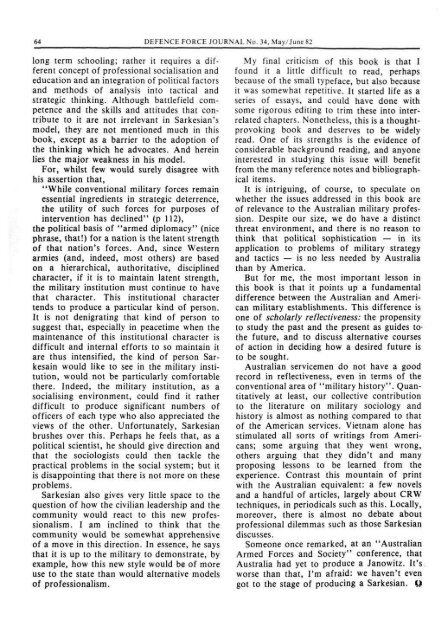ISSUE 34 : May/Jun - 1982 - Australian Defence Force Journal
ISSUE 34 : May/Jun - 1982 - Australian Defence Force Journal
ISSUE 34 : May/Jun - 1982 - Australian Defence Force Journal
You also want an ePaper? Increase the reach of your titles
YUMPU automatically turns print PDFs into web optimized ePapers that Google loves.
64 DEFENCE FORCE JOURNAL No. <strong>34</strong>, <strong>May</strong>/<strong>Jun</strong>e 82<br />
long term schooling; rather it requires a different<br />
concept of professional socialisation and<br />
education and an integration of political factors<br />
and methods of analysis into tactical and<br />
strategic thinking. Although battlefield competence<br />
and the skills and attitudes that contribute<br />
to it are not irrelevant in Sarkesian's<br />
model, they are not mentioned much in this<br />
book, except as a barrier to the adoption of<br />
the thinking which he advocates. And herein<br />
lies the major weakness in his model.<br />
For, whilst few would surely disagree with<br />
his assertion that,<br />
"While conventional military forces remain<br />
essential ingredients in strategic deterrence,<br />
the utility of such forces for purposes of<br />
intervention has declined" (p 112),<br />
the political basis of "armed diplomacy" (nice<br />
phrase, that!) for a nation is the latent strength<br />
of that nation's forces. And, since Western<br />
armies (and, indeed, most others) are based<br />
on a hierarchical, authoritative, disciplined<br />
character, if it is to maintain latent strength,<br />
the military institution must continue to have<br />
that character. This institutional character<br />
tends to produce a particular kind of person.<br />
It is not denigrating that kind of person to<br />
suggest that, especially in peacetime when the<br />
maintenance of this institutional character is<br />
difficult and internal efforts to so maintain it<br />
are thus intensified, the kind of person Sarkesain<br />
would like to see in the military institution,<br />
would not be particularly comfortable<br />
there. Indeed, the military institution, as a<br />
socialising environment, could find it rather<br />
difficult to produce significant numbers of<br />
officers of each type who also appreciated the<br />
views of the other. Unfortunately, Sarkesian<br />
brushes over this. Perhaps he feels that, as a<br />
political scientist, he should give direction and<br />
that the sociologists could then tackle the<br />
practical problems in the social system; but it<br />
is disappointing that there is not more on these<br />
problems.<br />
Sarkesian also gives very little space to the<br />
question of how the civilian leadership and the<br />
community would react to this new professionalism.<br />
I am inclined to think that the<br />
community would be somewhat apprehensive<br />
of a move in this direction. In essence, he says<br />
that it is up to the military to demonstrate, by<br />
example, how this new style would be of more<br />
use to the state than would alternative models<br />
of professionalism.<br />
My final criticism of this book is that I<br />
found it a little difficult to read, perhaps<br />
because of the small typeface, but also because<br />
it was somewhat repetitive. It started life as a<br />
series of essays, and could have done with<br />
some rigorous editing to trim these into interrelated<br />
chapters. Nonetheless, this is a thoughtprovoking<br />
book and deserves to be widely<br />
read. One of its strengths is the evidence of<br />
considerable background reading, and anyone<br />
interested in studying this issue will benefit<br />
from the many reference notes and bibliographical<br />
items.<br />
It is intriguing, of course, to speculate on<br />
whether the issues addressed in this book are<br />
of relevance to the <strong>Australian</strong> military profession.<br />
Despite our size, we do have a distinct<br />
threat environment, and there is no reason to<br />
think that political sophistication — in its<br />
application to problems of military strategy<br />
and tactics — is no less needed by Australia<br />
than by America.<br />
But for me, the most important lesson in<br />
this book is that it points up a fundamental<br />
difference between the <strong>Australian</strong> and American<br />
military establishments. This difference is<br />
one of scholarly reflectiveness: the propensity<br />
to study the past and the present as guides tothe<br />
future, and to discuss alternative courses<br />
of action in deciding how a desired future is<br />
to be sought.<br />
<strong>Australian</strong> servicemen do not have a good<br />
record in reflectiveness, even in terms of the<br />
conventional area of "military history". Quantitatively<br />
at least, our collective contribution<br />
to the literature on military sociology and<br />
history is almost as nothing compared to that<br />
of the American services. Vietnam alone has<br />
stimulated all sorts of writings from Americans;<br />
some arguing that they went wrong,<br />
others arguing that they didn't and many<br />
proposing lessons to be learned from the<br />
experience. Contrast this mountain of print<br />
with the <strong>Australian</strong> equivalent: a few novels<br />
and a handful of articles, largely about CRW<br />
techniques, in periodicals such as this. Locally,<br />
moreover, there is almost no debate about<br />
professional dilemmas such as those Sarkesian<br />
discusses.<br />
Someone once remarked, at an "<strong>Australian</strong><br />
Armed <strong>Force</strong>s and Society" conference, that<br />
Australia had yet to produce a Janowitz. It's<br />
worse than that, I'm afraid: we haven't even<br />
got to the stage of producing a Sarkesian. y

















